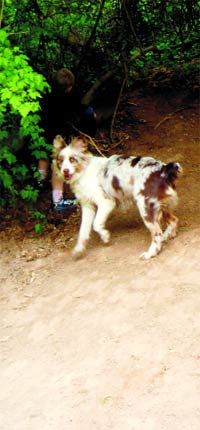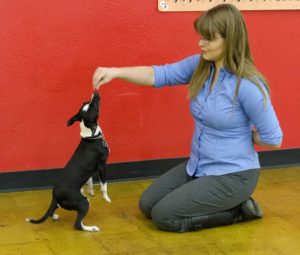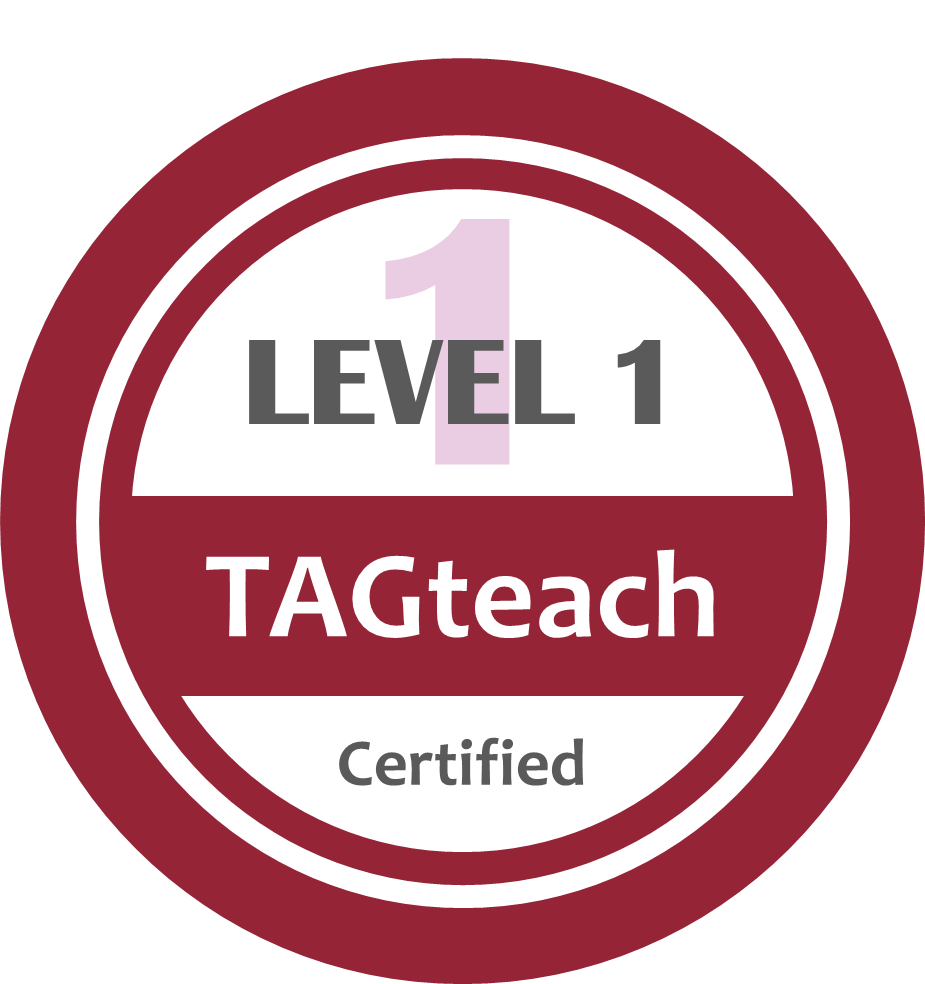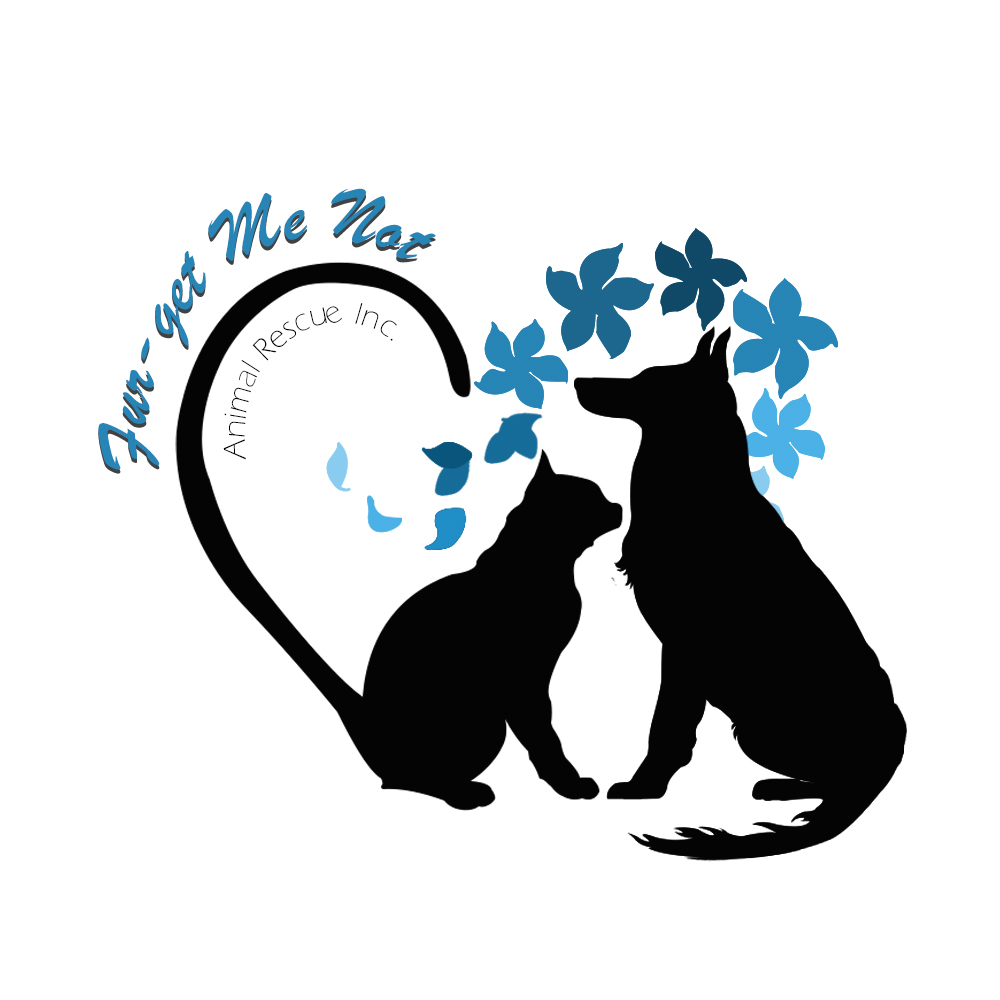Live in Ohio? Click Here
CONTACT US BELOW TO LEARN MORE.
ONLINE DOG TRAINING WORKS AND EMPOWERS YOU TO GET YOUR DOG TO LISTEN TO YOU. GAIN PEACE NOW. WE CAN HELP YOU NO MATTER WHERE YOU LIVE. ALL YOU NEED IS THE INTERNET
“Good Dog” Articles from the Catalyst Magazine
Ogden & Salt Lake City Dog Training Tips
Good Dog: Clicker Training
Johanna Teresi
 Editor’s note: If you read the CATALYST, chances are better than average that you’ve got a dog. So here’s a new monthly column on how to raise a trustworthy, calm and happy canine. (And yes, Johanna says, you can teach an old dog new tricks.)Okay, so you have gone to the store and seen clickers on the shelves. You may be asking yourself, “What are these?” A clicker can be a great tool to train animals with fun and rewards. When you train with a clicker, you teach your dog without force. (Clicker training has also been used with cats, fish and birds.) It is a positive technique. When your dog hears the clicking sound, he knows that he has performed the correct behavior. Therefore, he is more likely to perform the behavior again. Clicker training is a great way to teach your dog tricks and obedience commands. It will enable you to train sequences of behaviors such as “pick up and put away your toys!” You can also use clicker training to solve behavioral problems such as aggression, excessive barking or jumping, but in those cases it is best to consult a professional dog trainer. It is easy to inadvertently reward the bad behavior with inappropriate clicker timing. A professional can also suggest the best alternative behaviors to instill to lessen these behavioral problems.Starting clicker training is simple. First, you teach your dog that “click” means “treat.” You want your dog to anticipate the “click,” because he will know a treat is coming. Give your dog a treat immediately after clicking one time. It does not matter what the dog is doing when you click. Every time you click, the dog gets a treat.
Editor’s note: If you read the CATALYST, chances are better than average that you’ve got a dog. So here’s a new monthly column on how to raise a trustworthy, calm and happy canine. (And yes, Johanna says, you can teach an old dog new tricks.)Okay, so you have gone to the store and seen clickers on the shelves. You may be asking yourself, “What are these?” A clicker can be a great tool to train animals with fun and rewards. When you train with a clicker, you teach your dog without force. (Clicker training has also been used with cats, fish and birds.) It is a positive technique. When your dog hears the clicking sound, he knows that he has performed the correct behavior. Therefore, he is more likely to perform the behavior again. Clicker training is a great way to teach your dog tricks and obedience commands. It will enable you to train sequences of behaviors such as “pick up and put away your toys!” You can also use clicker training to solve behavioral problems such as aggression, excessive barking or jumping, but in those cases it is best to consult a professional dog trainer. It is easy to inadvertently reward the bad behavior with inappropriate clicker timing. A professional can also suggest the best alternative behaviors to instill to lessen these behavioral problems.Starting clicker training is simple. First, you teach your dog that “click” means “treat.” You want your dog to anticipate the “click,” because he will know a treat is coming. Give your dog a treat immediately after clicking one time. It does not matter what the dog is doing when you click. Every time you click, the dog gets a treat.
Make sure that you click at random times and unpredictable intervals. Practice clicking in a variety of rooms inside your house and also outside.
In this beginning stage of training, do not ask your dog to perform any commands when you click.
To reinforce the association between click and food, practice clicking and treating for three – seven days. When your dog’s ears go up (similar to a “food begging” expression), he probably understands that “click” means a yummy treat is following.
Next, train your dog a new behavior and click when your dog performs the correct response. (For aid on how to train obedience behaviors, read “Clicking with Your Dog,” by Peggy Tillman.) As before, every time you click you should give your dog a treat. Once your dog has learned the new command, you will no longer have to click. However, you will still occasionally reward your dog for performing the behavior.
It’s important to carry the clicker because it makes the reward immediate. You can click immediately when the behavior is performed. You will then have about two seconds to reward your dog.
A clicker helps with distance behaviors. When you ask your dog to sit when he is ten feet away from you, you need to be able to reward him before he begins to play with other dogs. The clicker allows you to mark the sitting behavior as soon as your dog sits. Your dog will know a treat is coming and will most likely run toward you or wait for you to come to him to receive his treat.
People talk constantly, and eventually, dogs ignore some of the chatter. A clicker is easily identifiable, and the dog knows at once that he has done something right when he hears it.
Clicking is fast. Speaking a word takes more than a second. A click is less than a second, making it much easier to mark a behavior that lasts for a split second.
Common clicker training problems
Many people click after the behavior instead of simultaneously with it. Practice your timing, and only train when you can focus 100% on your dog and your reaction time.
Coordinating the clicker, the treats and the leash can be difficult. Buy a treat bag, and only have a treat in your hand when rewarding your dog. You can wrap the leash around your waist or step on the leash, being careful it does not slip from under your foot. You can attach the clicker to your wrist with a wrist band.
Leaving the clicker at home when walking your dog is a mistake. When distractions are high, it is easier to train commands with a clicker. If you keep your clicker in your treat bag, it will be easy to remember.
Large treats will satiate your dog quickly. Pea to dime sized treats are perfect. Then your dog will crave more.
Resources
APDT.com: an excellent list of positive trainers all over the country who may use clicker training.
Clickertraining.com: books, DVDs and videos.
Bake Your Own Dog Treats!
Making your own treats for clicker training is a great way to give your dog proper nutrition and save money. Here is one simple recipe:
PUMPKIN DOGGIE COOKIES
12 cups oatmeal or quick oats
3 cups whole wheat flour
8 eggs
3/4 cup sunflower, fish, or olive oil
2/3 cup honey
1/2 cup molasses
2 cups milk
1 large can solid packed pumpkin
4 ripe mashed bananas
Place all ingredients into a large bowl. Mix together with your hands. Pat onto two large baking sheets with 3/4 inch sides. Bake at 325° for 50-60 minutes. Cut into dime-sized pieces.
Johanna Teresi is a professional dog trainer and owner of Four Legged Scholars LLC. fourleggedscholars.com.
Good Dog: Beat boredom, save a couch
Johanna Teresi
Just like people, dogs need mental stimulation. Training prevents boredom. Puppies trained at a young age are better behaved as adults. You should start training your puppy at eight weeks of age. As the puppy gets older, habits form and their learning rate becomes slower. Wouldn’t it be great to teach your puppy to sit instead of jump before she’s big enough to knock you down, and to walk nicely on the leash before he is strong enough to pull you over?
Contrary to popular belief, young puppy training is a great idea. Once your puppy has had his first set of vaccinations, register him in a group puppy class. The danger of developing behavioral problems as he gets older is much higher than of contracting diseases from a group puppy class. Group classes should be held in a clean indoor facility and include play between puppies. The play sessions teach the puppies bite inhibition and appropriate play behavior. The classes should teach basic commands. In addition, the puppies should be introduced to numerous stimuli with a positive associations before they reach 12 weeks of age.
A private trainer for your puppy can work well only if you are able to provide intense socialization with numerous types of friendly people and you are able to provide play sessions with other puppies or well-mannered adult dogs. Playtime should be held in your yard or your friend’s yard. Avoid dog parks where disease is more prevalent. If you are not able to meet these requirements, then a group class is the better choice.
Dogs six months or older will also benefit from training. Dogs at this age who have not been taught self-control or boundaries are more likely to develop problems such as aggression, excessive barking, house-soiling, jumping, begging, chewing on forbidden objects, excessive whining, separation anxiety and more. Although training at a later stage may help correct some of these problems, early preventive training is much more effective.
How does lack of training cause later behavioral problems? Dogs that have not been trained are more likely to feel insecure. Well-disciplined dogs trust their owners to help them through uncomfortable situations. But undisciplined dogs, lacking this trust, will be more likely to problem solve on their own when put in uncomfortable situations, and are more likely to develop more undesirable behaviors.
To prevent this, you want to incorporate the NILF (“nothing in life is free”) policy. Your dog must perform a command or exhibit good behavior before he receives something that he wants. For example, require your dog to “sit,” “down,” “stay,” or “watch,” before he may enter the car, walk through the door, eat his meal or chase his ball. Through this, the dog learns to ask for permission to receive a want. As a result, your dog will feel more secure and emotionally balanced.
So what are you waiting for? Build a fun and trusting relationship with your dog through some simple training.
Johanna Teresi is a professional dog trainer and owner of Four Legged Scholars LLC. fourleggedscholars.com.
Good Dog: Huh Come?
Johanna Teresi
 One of the most difficult commands to teach. “Come” is a life-saving word. Just think how nice it would be to call your dog back home after he darts out the door. What about when you take a nice off-leash hike and your dog chooses to come back to you rather than chasing that dangerous moose? I bet you can only dream of this response. Read on to learn how to make this fantasy a reality! First, let’s discuss the common mistakes committed when training “come.” The “come” word is often over-used and repeated when your dog does not respond. Many times your dog does not come and is rewarded for not coming by continuing to play. When the dog eventually obeys the command, the owner ends the fun activity and gives the dog a pat on the head. Get the picture? The dog learns that the command is irrelevant and that it is no fun to obey.Follow the directions below to train the emergency come (EC) command. First, choose a new word such as “here,” “pronto,” or “now.” The command will be saved for emergency use only. Also choose a special treat that your dog loves (cheese, chicken, turkey hotdogs). He will only get this treat for responding to this word. Have a helper gently hold your dog’s collar. Put some special treats in your hand. Walk directly to your dog’s muzzle and blatantly show him the treats you have. Then run away from your dog. Immediately when you begin running away, say the EC and your helper will let go of your dog’s collar. Run 10-20 feet. Then turn around and crouch down (rather than bending over) to grab your dog’s collar. While holding your dog’s collar, give him 20-30 seconds of the special treat. Make sure the quantity of the special treat given to your dog is low but the duration of the treat giving is high. Use crumb-sized pieces and give them to your dog one at a time for the duration of the reward.Next, stand stationary approximately ten feet away from your dog and say the EC. Grab the collar and give twenty – thirty seconds of the special treat. Gradually increase the coming distance to at least twenty feet. Complete the above process inside your house when your dog is not distracted. Make sure you practice in a variety of different rooms. Practice this process for at least a week.Now practice calling your dog when you and your dog are in different rooms and cannot see each other. Once again make sure you practice in a variety of different rooms. Practice this process for at least another week. For the following week, practice the above steps in a fenced backyard when your dog is not distracted. Switch to occasional rewards when your dog comes reliably without distractions.Remember, never call your dog unless you are 100% sure that he will come. Do not repeat the EC. If your dog is clicker trained, click when your dog is running toward you or when he reaches you. During this training month do not call your dog when he is distracted. Next month, we will take the next step and show how to train the EC with distractions.
One of the most difficult commands to teach. “Come” is a life-saving word. Just think how nice it would be to call your dog back home after he darts out the door. What about when you take a nice off-leash hike and your dog chooses to come back to you rather than chasing that dangerous moose? I bet you can only dream of this response. Read on to learn how to make this fantasy a reality! First, let’s discuss the common mistakes committed when training “come.” The “come” word is often over-used and repeated when your dog does not respond. Many times your dog does not come and is rewarded for not coming by continuing to play. When the dog eventually obeys the command, the owner ends the fun activity and gives the dog a pat on the head. Get the picture? The dog learns that the command is irrelevant and that it is no fun to obey.Follow the directions below to train the emergency come (EC) command. First, choose a new word such as “here,” “pronto,” or “now.” The command will be saved for emergency use only. Also choose a special treat that your dog loves (cheese, chicken, turkey hotdogs). He will only get this treat for responding to this word. Have a helper gently hold your dog’s collar. Put some special treats in your hand. Walk directly to your dog’s muzzle and blatantly show him the treats you have. Then run away from your dog. Immediately when you begin running away, say the EC and your helper will let go of your dog’s collar. Run 10-20 feet. Then turn around and crouch down (rather than bending over) to grab your dog’s collar. While holding your dog’s collar, give him 20-30 seconds of the special treat. Make sure the quantity of the special treat given to your dog is low but the duration of the treat giving is high. Use crumb-sized pieces and give them to your dog one at a time for the duration of the reward.Next, stand stationary approximately ten feet away from your dog and say the EC. Grab the collar and give twenty – thirty seconds of the special treat. Gradually increase the coming distance to at least twenty feet. Complete the above process inside your house when your dog is not distracted. Make sure you practice in a variety of different rooms. Practice this process for at least a week.Now practice calling your dog when you and your dog are in different rooms and cannot see each other. Once again make sure you practice in a variety of different rooms. Practice this process for at least another week. For the following week, practice the above steps in a fenced backyard when your dog is not distracted. Switch to occasional rewards when your dog comes reliably without distractions.Remember, never call your dog unless you are 100% sure that he will come. Do not repeat the EC. If your dog is clicker trained, click when your dog is running toward you or when he reaches you. During this training month do not call your dog when he is distracted. Next month, we will take the next step and show how to train the EC with distractions.
Surprise yourself with a dog that will come to you instantly!
Johanna Teresi is a professional dog trainer and owner of Four Legged Scholars LLC. fourleggedscholars.com.
Good Dog: Come…Again?
Johanna Teresi
Last month we discussed how to train an Emergency Come (EC) command in simple environments (inside your home and in your backyard). This month we will teach you how to train the EC to work in a world full of distractions. If you haven’t completed the homework in the previous article, make sure you do so before proceeding.
First, make a distraction list. Write it in hierarchical order from the easiest distraction for your dog to ignore to the hardest. Some examples are types of food, other animals and toys.
You will need:
• the distractions from your list.
• two other people.
• a large aluminum foil pie pan.
• the special chosen treat.
Variables you control:
• The distance your dog needs to run to come to you
• The quantity of distractions.
• The type of distractions and the environment.
When changing one variable, you will relax the other variables. For example, when using a new distraction, the distance should be relaxed. When increasing the distance, the type of distraction should be easy. Of course, you want to begin training with only one distraction at a time. When you have consistent and reliable EC response to one distraction progress to two or more distractions.
Remember to decrease the EC distance when adding more distractions. Increase the distance only when your dog comes well with a specific distraction at a short distance. Start training the EC inside your house rather than outside. Then you will graduate to training the EC in your backyard and finally in other outside environments.
Now let’s get training!
Person #1 holds your dog by the collar, and you stand five to 10 feet away. Place the chosen distraction (such as a pig’s ear) between you and Person #1, in your dog’s predicted path.
Person #2 stands close to the distraction holding the pie pan.
You walk up to Person #1 and blatantly show your dog the special treats. Then you immediately run away from your dog, past the distraction, while simultaneously saying the EC command.
Person #1 Releases your dog’s collar. Stop running when you are about ten feet away from your dog’s starting point. Person #2 should be ready to cover the distraction with the pie pan if your dog attempts to investigate the distraction.
If your dog comes readily and barely pays attention to the distraction, reward him with twenty – thirty seconds of treats as described in last month’s article. You may also let him interact with the distraction briefly. Repeat the exercise five to ten times.
Now stand five feet away from your dog when you show the treat, run an extra five to ten feet. Repeat this increased distance five to ten times. Finally, stand stationary ten feet away and use the EC. Repeat this exercise until your dog responds to the EC without paying attention to the completely visible distraction. In other words, Person #2 should no longer need to cover the distraction with a pie pan.
Now you will increase the EC distance with that particular distraction by one to two feet and repeat the exercise. Gradually increase the EC distance in one- to two-foot increments until your dog comes when you are twenty to fifty feet away.
Repeat the entire process with the next distraction on your list, and the next until you have completed the above exercise with all of the distractions on the list. Finally, practice these mastered distractions in your backyard and then in more public environments.
What do you do if your dog just isn’t coming with a particular distraction? As emphasized in last month’s article, do not repeat the command. Approach your dog and display the special treat, but take the treat and act like you are eating it. If another dog is around, praise that dog while giving him the treat instead. This works particularly well if you own more than one dog or if another dog is readily available. Now start the exercise over and call him again, but make the exercise easier by changing one or more of the variables as described above (say, the distance or the environment). You may also need to prompt your dog by running away or showing the treats before calling him.
If you (or you dog) has trouble getting the concept, contact a professional reward-based trainer. Most are listed on APDT.com or ClickerTeachers.net.
Work hard, and soon you will be able to walk your dog off leash with an excellent response to the EC!
Johanna Teresi is a professional dog trainer and owner of Four Legged Scholars LLC. fourleggedscholars.com.
Good Dog: After “Sit” Comes “Down”
Johanna Teresi
I bet your dog listens to “sit,” but “down” is more of a challenge. Or maybe your dog will only “down” from a sitting position, but not from a standing one. Maybe your dog “downs” with no problem, but your back is beginning to hurt from bending all the way over to the floor to signal the down.First, let’s start with the basics. With a treat ready in your hand, ask your dog to sit. Then take the treated hand and immediately place it directly under your dog’s muzzle and move your hand down to the floor. Keeping it on the floor, move your hand away from your dog. Do not say the “down” command. Your dog will probably follow the treat. If your dog “downs,” reward with a C/T (click and treat). Repeat five – ten times. Now add the “down” command immediately before you lure your dog with a treat. C/T when your dog is in the “down” position. Repeat five – ten times. Then switch to occasional rewards.If your dog pops up from the sit when you try to lure him into a “down,” you may need to first move your hand downward in a straight line instead of down and out. Gently hold your dog from popping up by placing your free hand on your dog’s back with very little pressure.Maybe your dog just doesn’t want to go into a “down” at all. Sit on the floor and raise one leg with your foot still on the floor so that your leg forms an arc. The goal will be to get your dog to crawl under your leg. Your leg should be just low enough so that when your dog is under he is forced to stay in the “down” position, but your leg should not be exerting pressure on your dog’s back. First, you will reward your dog for inching toward your leg. Repeat this step five – ten times. Next, reward your dog for inching toward your leg again, but this time your dog should be a bit closer than in the previous step. Repeat this five – ten times. Gradually increase the distance that your dog needs to travel until his head is under your leg. Repeat each step five – ten times. Keep gradually increasing the amount of your dog’s body that is moving under your leg. When your dog’s back is under your leg, which gently forces the dog into the “down,” you have reached your goal. Remember to repeat and C/T each approximation five – ten times. Once your dog readily “downs” with your leg, try to remove your leg and lure your dog into the “down” as described in paragraph two.Some dogs will only “down” from a sit but not from a stand. You can use behavior catching to solve this problem. Watch your dog throughout the day, and when you see that your dog is about to “down” voluntarily, immediately say “down.” Then C/T the “down.” If this doesn’t work, then try luring your dog under your leg as described above.
The final step after your dog will “down” without a treat lure is to change your hand motion to the floor to a hand signal. First ask your dog to “down” by lowering your open hand, palm down, to the floor. Gradually lessen the amount you lower your hand until the motion becomes a subtle signal which you can make without bending over. Remember to change in gradual steps and C/T each step five – ten times before changing to the next. When your dog “downs” reliably with the hand signal, switch to occasional rewards.
Great! Now your dog really does know how to “down!”
Johanna Teresi is a professional dog trainer and owner of Four Legged Scholars LLC. fourleggedscholars.com.
Good Dog: Leave That Alone, Please!
Johanna Teresi
 Does your dog stick his nose or mouth in forbidden places? As soon as you drop food on the floor or turn your back to the meat on your kitchen counter, it’s gone! Maybe he even jumps on your children to grab a burger out of their hands. During walks your dog’s nose is glued to the ground, and as soon as he spots some leftover fries, they are history. Or maybe your puppy still grabs forbidden objects. All of the above can be remedied with one simple command: “Leave it. “Teach the “leave it” command in consecutive steps. On each step, the idea is to wait until you can predict that the “leave it” behavior will occur promptly. When you present the object that you want your dog to leave, your dog should perform one of the following actions: head turning, backing up or looking at your face. Each of these behaviors, show “leave it behavior” (LIB). Practice each of the steps below with a variety of different objects, such as your dog’s toys and human food. Also, practice each step in a variety of environments. If your dog is clicker trained, click and treat when your dog exhibits LIB.The first and easiest step involves a treat in your closed hand. The treat should be completely invisible to your dog as you present your hand before his muzzle. Keep your hand stationary. Your dog will naturally lick, paw, bite, and maybe bark to try to get the treat. (Please consult a professional reward-based trainer if your dog’s barking or biting is obsessive or injures someone.) If your dog bites your hand or barks, immediately move your hand behind your back or just walk away. Wait and then re-present your hand. Eventually, your dog will give up and exhibit LIB. Say, “leave it” at this time and immediately treat your dog from your opposite hand while, saying, “take it.” Give the treat to your dog between your thumb and pointer finger rather than in your open palm. He is learning that “leave it” is distinctly different from “take it.” Place the treat-bearing “leave it” hand behind your back and re-present it. Repeat this until your dog performs the LIB as soon as the treat-bearing hand is presented. At this point in the training, you will say, “leave it” while simultaneously presenting the concealed treat, and your dog should promptly demonstrate LIB. Repeat this part of the training at least ten times.For the next step you will present a treat directly under your dog’s muzzle, but this time the treat rests in your open palm. Your hand will remain stationary except for opening or closing it. If your dog attempts to snatch the treat, close your hand. When he moves away from the hand, open it again. Repeat opening and shutting until your dog exhibits LIB with the visible treat in your open hand. Immediately say “leave it” when the LIB is displayed. Then say, “take it” and treat your dog from your opposite hand. Place the treat-bearing “leave it” hand behind your back and re-present it. Once your dog readily displays LIB with your open hand, say “leave it” as soon as you present the treat. Repeat at least ten times.Perform the same process, but now work on the LIB with a treat under your foot. Then you will work on the LIB with the treat visible on the ground and your foot covering and uncovering the treat until your dog displays the LIB with the treat uncovered.Now the fun begins as you incorporate the command in your dog’s everyday life. If your dog has trouble, review any of the above steps with the object. When your guests drop food on the floor, surprise them with your dog’s excellent response to a “leave it” command.
Does your dog stick his nose or mouth in forbidden places? As soon as you drop food on the floor or turn your back to the meat on your kitchen counter, it’s gone! Maybe he even jumps on your children to grab a burger out of their hands. During walks your dog’s nose is glued to the ground, and as soon as he spots some leftover fries, they are history. Or maybe your puppy still grabs forbidden objects. All of the above can be remedied with one simple command: “Leave it. “Teach the “leave it” command in consecutive steps. On each step, the idea is to wait until you can predict that the “leave it” behavior will occur promptly. When you present the object that you want your dog to leave, your dog should perform one of the following actions: head turning, backing up or looking at your face. Each of these behaviors, show “leave it behavior” (LIB). Practice each of the steps below with a variety of different objects, such as your dog’s toys and human food. Also, practice each step in a variety of environments. If your dog is clicker trained, click and treat when your dog exhibits LIB.The first and easiest step involves a treat in your closed hand. The treat should be completely invisible to your dog as you present your hand before his muzzle. Keep your hand stationary. Your dog will naturally lick, paw, bite, and maybe bark to try to get the treat. (Please consult a professional reward-based trainer if your dog’s barking or biting is obsessive or injures someone.) If your dog bites your hand or barks, immediately move your hand behind your back or just walk away. Wait and then re-present your hand. Eventually, your dog will give up and exhibit LIB. Say, “leave it” at this time and immediately treat your dog from your opposite hand while, saying, “take it.” Give the treat to your dog between your thumb and pointer finger rather than in your open palm. He is learning that “leave it” is distinctly different from “take it.” Place the treat-bearing “leave it” hand behind your back and re-present it. Repeat this until your dog performs the LIB as soon as the treat-bearing hand is presented. At this point in the training, you will say, “leave it” while simultaneously presenting the concealed treat, and your dog should promptly demonstrate LIB. Repeat this part of the training at least ten times.For the next step you will present a treat directly under your dog’s muzzle, but this time the treat rests in your open palm. Your hand will remain stationary except for opening or closing it. If your dog attempts to snatch the treat, close your hand. When he moves away from the hand, open it again. Repeat opening and shutting until your dog exhibits LIB with the visible treat in your open hand. Immediately say “leave it” when the LIB is displayed. Then say, “take it” and treat your dog from your opposite hand. Place the treat-bearing “leave it” hand behind your back and re-present it. Once your dog readily displays LIB with your open hand, say “leave it” as soon as you present the treat. Repeat at least ten times.Perform the same process, but now work on the LIB with a treat under your foot. Then you will work on the LIB with the treat visible on the ground and your foot covering and uncovering the treat until your dog displays the LIB with the treat uncovered.Now the fun begins as you incorporate the command in your dog’s everyday life. If your dog has trouble, review any of the above steps with the object. When your guests drop food on the floor, surprise them with your dog’s excellent response to a “leave it” command.Johanna Teresi is a professional dog trainer and owner of Four Legged Scholars LLC. fourleggedscholars.com. Find out more about professional reward based dog training at APDT.com.
Good Dog: Pay Attention to Me!
Johanna Teresi
Does your dog barely acknowledge you during your daily walks? Teaching your dog to “watch,” or look at you on command, is very helpful. You can use “watch” and your dog will ignore a nearby distraction such as your dog’s best friend. When your dog is looking at you, his eyes and attention are focus on you. You will have a much easier time requesting other commands such as “sit,” “down” and “stay.” Also, “watch” can relax your dog. If he is whining or barking, this command will usually quiet him. Eventually your dog will “watch” you voluntarily, and he will be more attentive to you during your walks. Finally, if your dog has aggressive behavior, “watch” is an excellent alternative to lunging. Be certain to consult a professional reward-based dog trainer for aggressive dogs (Four Legged Scholars). “Watch” is easy to teach. Because the “watch” behavior tends to happen quickly, it is easier to teach if your dog is clicker trained (Read the first article titled “Clicker Training.”). Place a visible treat in your hand, then lower your hand to the dog’s muzzle. Next, move your hand diagonally to your eyes; your dog will follow the motion and give you direct eye contact. Click and treat (C/T) immediately when your dog’s eyes meet with yours, even if the eye contact lasts less than a second. Practice this five to ten times. Say “watch,” and repeat the same hand movement without the treat in your hand. C/T when your dog’s eyes meet yours. Practice this five to ten times. Now use the verbal command without the hand movement – say “watch” with your hands stationary at your side. C/T when your dog’s eyes meet yours. Practice this five to ten times. Once your dog is readily watching you on command, you may occasionally reward him with a treat.Of course, a short “watch” is not effective in keeping your dog’s attention. The next step is to gradually increase the duration of your dog’s “watch” in one second increments. Practice and C/T five to ten times at each new time interval. When your dog readily “watches” you for one second, increase the “watch” to two seconds. Then repeat the same for three four and so on until you reach your desired duration (probably five to ten seconds). As soon as your dog gives reliable eye contact for the desired length of time, reduce the rewards to an occasional treat. You will also want to vary the duration of the “watches” so that your dog does not have to “watch” you for ten seconds every time. Otherwise, your dog may learn to dread the command because he knows that the “watch” will always be long and boring!Lastly, teach your dog to retain his “watch” in the midst of distractions. As you add distractions, decrease the duration of the “watch.” Once your dog “watches” well for short durations with distractions, you should increase the time duration. Remember to C/T your dog’s “watches” until they are reliable with distractions; then you can switch to occasional rewards.Now when you walk your dog, you can feel you’re really communicating with your pet, who listens to you rather than jumping, barking or running toward passersby!
Johanna Teresi is a professional dog trainer and owner of Four Legged Scholars LLC. fourleggedscholars.com.
Good Dog: Help! My Dog Jumps Too Much!
Johanna Teresi
Is your dog so happy to see people that he jumps and licks them in the face? Of course your guests like a friendly hello, but some probably think this is too much! What can you do about it? Teach your dog to sit instead of jump. First, put your dog on leash. To keep your hands free, you may tether the leash to a heavy object. (Note: The tether is not a means to leave your dog unsupervised.) You may also securely step on the leash. If you are holding your dog on a leash, remain stationary. Allow a person to approach your dog. As soon as your dog seems ready to jump, have the person turn around and walk in the opposite direction so that he is out of your dog’s reach. Have the person approach again, and if the dog tries to jump, repeat the leaving process. If your dog chooses to sit, the person may reward the dog with a treat or a pat. Repeat this sequence, practicing with multiple people until your dog immediately sits with the approach of any person. Keep treats near your front door and stashed all around your house. Upon a visitation, give your guest some treats. Tell your guest to give your dog a reward only after he performs a command. Two great commands to use are “sit” and “down.”Always take treats when you walk your dog. Whenever anyone asks to pet your dog, give the person some treats and practice the above scenario.Direct eye contact or yelling at your dog are signs of attention and actually reward the jumping behavior. Instead, ignoring your dog works great as a punishment. If your dog jumps on you while you are standing, turn your head or your entire body away. The same technique applies if your dog is off leash and jumping on someone else. If you are sitting and your dog jumps on you, simply stand up and walk away.Also training “place” is a great way to teach your dog to go to a specific place on command and stay there until released (See the article below titled “Teaching Your Dog to Settle.”). Your dog cannot jump on people if he is staying on his place.
If your dog is clicker-trained, click the behavior that you would like him to repeat (for example, “sit”), and then give your dog a treat.
If the above techniques do not work for you, please consult a
professional positive reinforcement (reward-based) trainer.
Your guests will be impressed to see a dog that automatically sits when they reach to pet him. You will appreciate your dog’s new-found calm behavior, and your dog will be happier, too!
Johanna Teresi is a professional dog trainer and owner of Four Legged Scholars LLC. fourleggedscholars.com.
Good Dog: Teaching Your Dog to Settle
Johanna Teresi
Training your dog to go to a certain place on command until released is very helpful. Wouldn’t it be great to have your dog calmly lying down while you answer the door or while you are eating dinner? How about having your dog lay down after being exercised? Many dog trainers refer to this behavior as “place.”To teach this behavior, you will need the following: a treat bag, a clicker, a designated place for your dog to lie (preferably a bed or a crate), and many dime-sized treats. Follow the steps below to teach your dog to go to his place. First, stand directly in front of the designated place. Say “place,” and then throw a treat onto the place while you move your arm in an exaggerated fashion, as if you were throwing a ball underhand. Click as soon as your dog goes onto his place. After your dog eats his treat, ask him to “down.” Click and treat (C/T) as soon as your dog downs on his place. C/T a few times while your dog stays in a down for a few seconds. Say “okay” and walk away to release your dog from the place. Repeat five to ten times.Repeat the above step, except when making your exaggerated arm movement do not throw a treat. As soon as your dog goes to his place, C/T. Remember to ask your dog to “down” and keep him down for a few seconds. Repeat five to ten times.After your dog consistently goes to his place on command, you will occasionally C/T when your dog goes to his place. For the times you do not treat, use praise instead. Repeat five to ten times.Now you are able to teach your dog to go to his place from a distance. First, stand a short distance (about one foot) away from your dog’s place, and repeat the above steps. Gradually increase your distance from your dog’s place until you have reached the designated distance (ten-twenty feet) that you would like to be from the place while commanding him.
The last step is to teach your dog to stay on his place for a longer time period. Once your dog follows the “place” command, give your dog a chew toy, such as a cow hoof or kong. Before your dog has lost interest in the chew toy, take it away, and say “okay”. Gradually increase the time period to one minute, working up to ten to twenty minutes. After your dog reliably stays on his place, you will no longer have to give your dog a chew toy.
Now your dog will relax with you while you watch a movie with a friend!
Johanna Teresi is a professional dog trainer and owner of Four Legged Scholars LLC. FOURLEGGEDSCHOLARS.COM. Visit: catalystmagazine.net and see the January article “Clicker Training.”
Good Dog: Leash Walking
Johanna Teresi
 It’s a common sight-a dog dragging his owner. Dogs that pull can tempt owners to exercise their dog only off leash, which, of course, can be dangerous. It also can restrict young or elderly family members from participating in dog walks.
It’s a common sight-a dog dragging his owner. Dogs that pull can tempt owners to exercise their dog only off leash, which, of course, can be dangerous. It also can restrict young or elderly family members from participating in dog walks.Walking with your dog on a loose leash is much easier. This month we will discuss how to train leash walking on a normal flat collar.
Use a flat collar (a leather or cloth collar with a buckle or snap), not a choker or prong collar. You will also need a four to six-foot cloth or leather leash. Do not use a flexi-leash. If your dog bites the leash, you may want to try a chain leash. A clicker with a wrist band and a treat bag that attaches to your pants can be very helpful. Yummy treats such as Natural Balance dog food rolls, cheese, or turkey hot dogs are great choices. Avoid dry treats. The treats should be pea- to dime-sized. You’ll want enough to fill a sandwich-size zip-lock bag.
Coordination is the hardest part. Sometimes it is helpful to practice these methods without your dog or in the house with low distractions.
Choose which side you would like your dog to walk on. If you choose your left side, hook your treat bag on your left hip and hold the clicker in your right hand. Place the end loop of the leash in your right hand, grabbing another section of the leash one to three feet below the loop. The remaining leash length should allow your dog to walk one or two feet ahead of you. The leash should cross in front of you, so you can also hold it with your left hand for extra leverage, which may be necessary with strong pullers. Reverse this arrangement if you want your dog to walk on your right.
At the beginning of the training process, you can’t expect your dog to walk nicely on the leash for thirty- to sixty-minutes. Start with multiple five- to fifteen-minute walks throughout the day. Then gradually increase the length of your walks. Also, supplement your dog’s exercise through play with other friendly dogs or games such as fetch.
Your goal is to reward proper leash walking without the dog pulling forward or outward on the leash. The leash should never be tense. Your dog does not have to heel, and it’s okay if he stops to smell. When your dog is walking nicely on the leash, say “easy,” and click and treat (C/T) with your left hand (if you’re training the dog to walk on the left side). Hold the treat behind your knee so you don’t encourage your dog’s head to cross in front of your legs.
Keep the C/T frequency high until your dog readily walks politely on the leash. Praising your dog for proper leash walking will also encourage it.
If your dog pulls forward on the leash, say “easy” and immediately begin a gradual turn in the opposite direction of your pulling dog. Then promptly C/T your dog for being in the correct position. Do not pop the leash on your dog’s neck.
Eventually, your dog should respond to “easy” without prompting. At first, you will be changing directions frequently. As your dog’s leash-walking behavior improves, switch from frequent to occasional treat rewards rather than terminating the treats.
Now take your dog for a walk and have a great time!
Johanna Teresi is a professional dog trainer and owner of Four Legged Scholars LLC. fourleggedscholars.com
Complete the Contact Form Below to Gain Peace of Mind Now.
We understand your struggles and you've come to the right place! We care about your success, and we will take you through a step by step process to coach you in getting your dog to listen. Please complete the form below to learn how we can personally help you and your dog.
Get in Touch By Phone Or email
We have a wide variety of course options that are sure to work with your needs. Get on the path to your peace of mind today!
Phone: (801) 463-1668
Email: Info@FourLeggedScholars.com
Address:
Four Legged Scholars LLC
4050 S 2700 E, Salt Lake City, UT 84124






